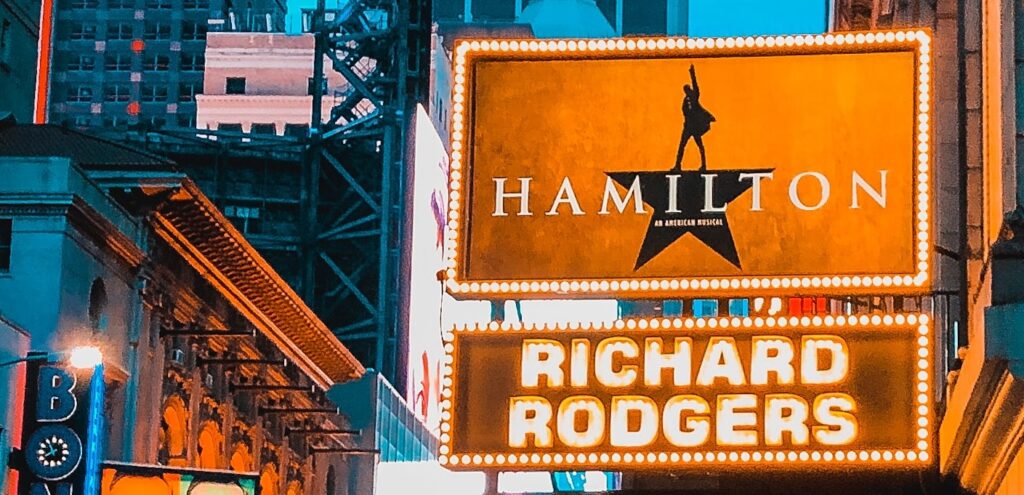Leadership in the Spotlight
Today’s Tuesday Reading is from Dr. Rachel Groenhout, Director of Data and Change Management at Colby College. She is a recent MOR alum. Rachel may be reached at [email protected] or via LinkedIn.
Editorial Note: This is the last Tuesday Reading of 2023. The next Tuesday Reading will be in January.
Recently, I went to New York City to see Hamilton live on Broadway after a few years of enjoying the soundtrack’s unique style. While I took in the imposing set before the show commenced, the MOR exercise of Leadership as a Performance Art (LPA) came into my mind. In the MOR conceptualization of LPA, the focus is on analyzing our own leadership roles that we tend to play (e.g., Planner, Visionary, etc.) and reflecting on what leadership roles are most needed in any given situation. While we may, as individuals and as leaders, tend towards specific roles or functions, we can exercise our leadership muscles to lean more deeply into roles that may not be our most comfortable ones. In this way, LPA encourages us to expand the repertoire of characters/roles that we can play–and indeed are willing to play–beyond our own natural selves.
Opposing Roles
In the musical Hamilton, two of the main characters are similarly ambitious, but each utilize their own favorite strategy to achieve their goals. While Alexander Hamilton embraces a bold seize-the-day philosophy, Aaron Burr exhibits a quietly opportunistic approach. When Hamilton sees the glimmer of an opportunity, he pounces, loudly and publicly, proclaiming: “I am NOT throwing away my shot!” In contrast, when Burr sees an opportunity, he carefully calculates who and what he can subtly influence to get what he wants, switching political parties and betraying his friends to capitalize on opportunities.
When Hamilton and Burr first meet in the musical, Burr gives Hamilton political advice:
Talk less, smile more:
Don’t let them know what you’re against or what you’re for…
Fools who run their mouths often wind up dead.
A few moments later comes Hamilton’s icy retort:
If you stand for nothing, Burr, what will you fall for?!
While listening to the Hamilton soundtrack over the past few years, I have often compared the two characters’ vastly differing approaches. Only through the MOR Leadership as a Performance Art exercise did I begin to think about the phenomenal leader that could be by combining Hamilton’s boldness with Burr’s political maneuvering. While each man led with his own natural style, those styles fit some situations better than others. Leadership as a Performance Art encourages us to cultivate additional roles beyond our most comfortable ones. LPA shows us what we can gain by expanding our repertoire rather than perfecting a particular role that may be our most natural one.
Intentionally Rotating Roles in the Spotlight
If Hamilton and Burr were leaders in our organizations, neither style—individually—would be entirely successful. Like Hamilton, we should dare to lead from where we are. Like Burr, we should be mindful to read the political landscape and not take the spotlight when doing so puts a target on our backs. And, of course, many other roles should be added to our repertoires.
As I contemplate this expansion of characters and leadership roles, the mantra “Be Intentional” consistently answers the question: Why this style? Why now? What next? Great leaders thoughtfully step up, step forward, step back, and step aside as contexts evolve. We need broad repertoires and intentionality to select the most appropriate character to place in the spotlight at each moment. And we must remember to step out of the spotlight often; the fact that “the answer is in the room” is not enough if we don’t clear the stage and invite those who might otherwise remain silent to step into the spotlight.
Choosing Leading Roles
Leadership as a Performance Art encourages us to thoughtfully consider which roles to leverage, at which times, and for which desired outcomes. Though we might tend to continuously inhabit a role that best fits our personality, our style, or our role in our organization, the challenge is to get on the balcony and observe holistically. What role do we lean into for a given purpose? Who do we usher off-stage to allow another character to take the spotlight? As we perform/lead day after day and week after week, if we observe and reflect from the balcony, we will more accurately assess, for example, when the Visionary should lead and the Planner should follow (and vice versa).
I am challenging myself to observe and reflect, and to adopt leadership roles I haven’t typically inhabited in the past to broaden my repertoire of characters I can effectively (and–perhaps in time–comfortably) play. While we need to emulate more characters than just Hamilton and Burr, I find the dueling personalities to be a helpful illustration of how vastly different leaders choose to lead. Ultimately, each leadership style we enact is a choice. What leadership roles will you choose to further develop and challenge yourself to more frequently bring into the spotlight?

As you consider Leadership as a Performance Art and the roles you play, where do you most want to focus?
Last week we asked which is hardest to keep in balance for you as a leader?
- 41% said being decisive.
- 32% said being empathetic.
- 27% said being reasonable.
Considering our readership base as a whole, keeping reasonableness in balance as a leader tends to come easiest whereas being decisive is the hardest to keep in balance for over 2 our of every 5 readers. For those of you interested in sharpening your decisiveness skill set, check out this previous Tuesday Reading on the Understand, Recognize, Analyze, Decide, and Implement decision-making framework.

- October 2025 (3)
- September 2025 (5)
- August 2025 (7)
- July 2025 (5)
- June 2025 (4)
- May 2025 (5)
- April 2025 (5)
- March 2025 (4)
- February 2025 (4)
- January 2025 (4)
- December 2024 (3)
- November 2024 (4)
- October 2024 (5)
- September 2024 (4)
- August 2024 (4)
- July 2024 (5)
- June 2024 (5)
- May 2024 (4)
- April 2024 (5)
- March 2024 (5)
- February 2024 (4)
- January 2024 (5)
- December 2023 (3)
- November 2023 (4)
- October 2023 (5)
- September 2023 (4)
- August 2023 (4)
- July 2023 (4)
- June 2023 (4)
- May 2023 (5)
- April 2023 (4)
- March 2023 (1)
- February 2023 (1)
- January 2023 (4)
- December 2022 (3)
- November 2022 (5)
- October 2022 (4)
- September 2022 (4)
- August 2022 (5)
- July 2022 (4)
- June 2022 (4)
- May 2022 (5)
- April 2022 (4)
- March 2022 (4)
- February 2022 (3)
- January 2022 (4)
- December 2021 (3)
- November 2021 (4)
- October 2021 (3)
- September 2021 (4)
- August 2021 (4)
- July 2021 (4)
- June 2021 (4)
- May 2021 (4)
- April 2021 (4)
- March 2021 (5)
- February 2021 (4)
- January 2021 (4)
- December 2020 (4)
- November 2020 (4)
- October 2020 (6)
- September 2020 (5)
- August 2020 (4)
- July 2020 (7)
- June 2020 (7)
- May 2020 (5)
- April 2020 (4)
- March 2020 (5)
- February 2020 (4)
- January 2020 (4)
- December 2019 (2)
- November 2019 (4)
- October 2019 (4)
- September 2019 (3)
- August 2019 (3)
- July 2019 (2)
- June 2019 (4)
- May 2019 (3)
- April 2019 (5)
- March 2019 (4)
- February 2019 (3)
- January 2019 (5)
- December 2018 (2)
- November 2018 (4)
- October 2018 (5)
- September 2018 (3)
- August 2018 (3)
- July 2018 (4)
- June 2018 (4)
- May 2018 (5)
- April 2018 (4)
- March 2018 (5)
- February 2018 (5)
- January 2018 (3)
- December 2017 (3)
- November 2017 (4)
- October 2017 (5)
- September 2017 (3)
- August 2017 (5)
- July 2017 (3)
- June 2017 (8)
- May 2017 (5)
- April 2017 (4)
- March 2017 (4)
- February 2017 (4)
- January 2017 (4)
- December 2016 (2)
- November 2016 (7)
- October 2016 (5)
- September 2016 (8)
- August 2016 (5)
- July 2016 (4)
- June 2016 (12)
- May 2016 (5)
- April 2016 (4)
- March 2016 (7)
- February 2016 (4)
- January 2016 (10)
- December 2015 (4)
- November 2015 (6)
- October 2015 (4)
- September 2015 (7)
- August 2015 (5)
- July 2015 (6)
- June 2015 (12)
- May 2015 (4)
- April 2015 (6)
- March 2015 (10)
- February 2015 (4)
- January 2015 (4)
- December 2014 (3)
- November 2014 (5)
- October 2014 (4)
- September 2014 (6)
- August 2014 (4)
- July 2014 (4)
- June 2014 (4)
- May 2014 (5)
- April 2014 (5)
- March 2014 (5)
- February 2014 (4)
- January 2014 (5)
- December 2013 (5)
- November 2013 (5)
- October 2013 (10)
- September 2013 (4)
- August 2013 (5)
- July 2013 (8)
- June 2013 (6)
- May 2013 (4)
- April 2013 (5)
- March 2013 (4)
- February 2013 (4)
- January 2013 (5)
- December 2012 (3)
- November 2012 (4)
- October 2012 (5)
- September 2012 (4)
- August 2012 (4)
- July 2012 (5)
- June 2012 (4)
- May 2012 (5)
- April 2012 (4)
- March 2012 (4)
- February 2012 (4)
- January 2012 (4)
- December 2011 (3)
- November 2011 (5)
- October 2011 (4)
- September 2011 (4)
- August 2011 (4)
- July 2011 (4)
- June 2011 (5)
- May 2011 (5)
- April 2011 (3)
- March 2011 (4)
- February 2011 (4)
- January 2011 (4)
- December 2010 (3)
- November 2010 (4)
- October 2010 (4)
- September 2010 (3)
- August 2010 (5)
- July 2010 (4)
- June 2010 (5)
- May 2010 (4)
- April 2010 (3)
- March 2010 (2)
- February 2010 (4)
- January 2010 (4)
- December 2009 (4)
- November 2009 (4)
- October 2009 (4)
- September 2009 (4)
- August 2009 (3)
- July 2009 (3)
- June 2009 (3)
- May 2009 (4)
- April 2009 (4)
- March 2009 (2)
- February 2009 (3)
- January 2009 (3)
- December 2008 (3)
- November 2008 (3)
- October 2008 (3)
- August 2008 (3)
- July 2008 (4)
- May 2008 (2)
- April 2008 (2)
- March 2008 (2)
- February 2008 (1)
- January 2008 (1)
- December 2007 (3)
- November 2007 (3)
- October 2007 (3)
- September 2007 (1)
- August 2007 (2)
- July 2007 (4)
- June 2007 (2)
- May 2007 (3)
- April 2007 (1)
- March 2007 (2)
- February 2007 (2)
- January 2007 (3)
- December 2006 (1)
- November 2006 (1)
- October 2006 (1)
- September 2006 (3)
- August 2006 (1)
- June 2006 (2)
- April 2006 (1)
- March 2006 (1)
- February 2006 (1)
- January 2006 (1)
- December 2005 (1)
- November 2005 (2)
- October 2005 (1)
- August 2005 (1)
- July 2005 (1)
- April 2005 (2)
- March 2005 (4)
- February 2005 (2)
- December 2004 (1)